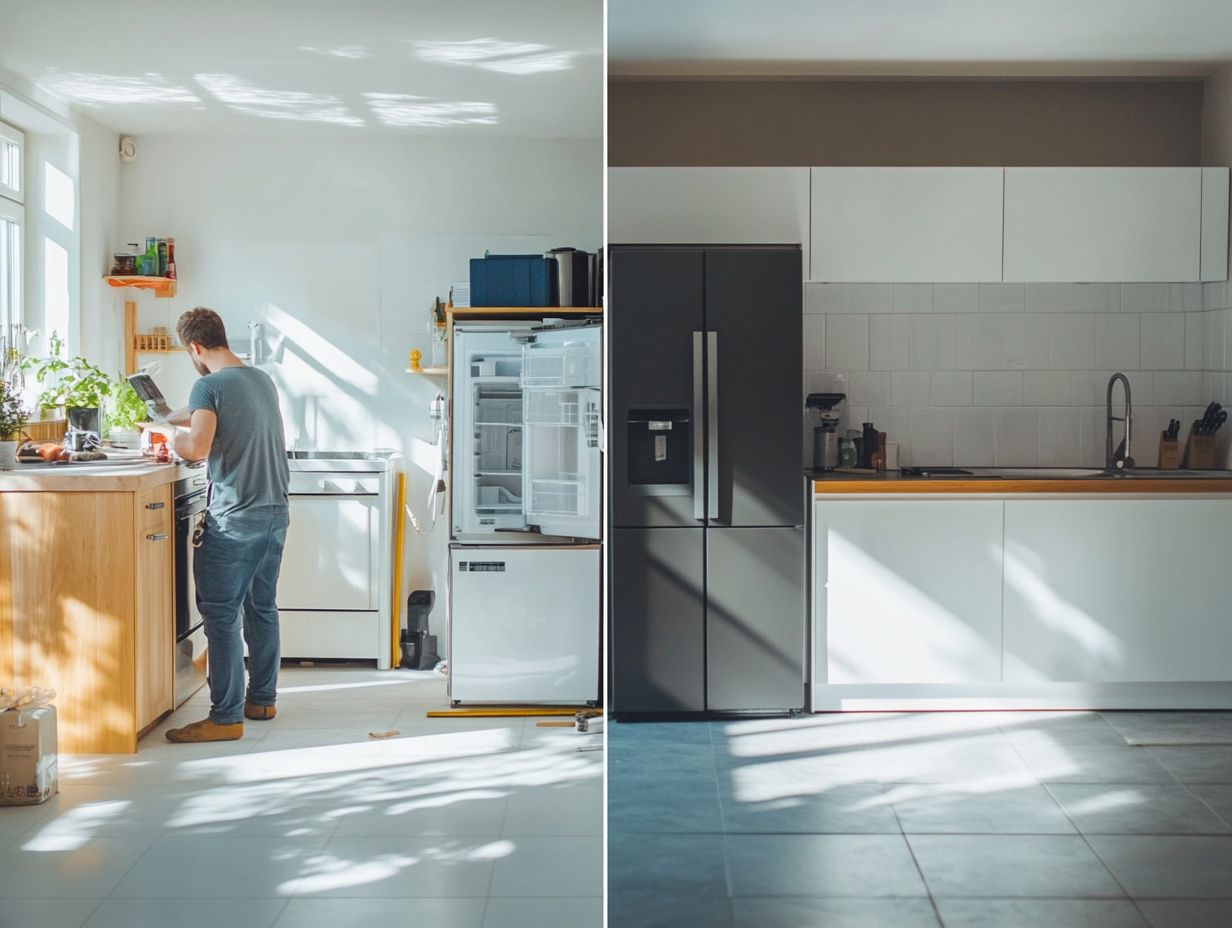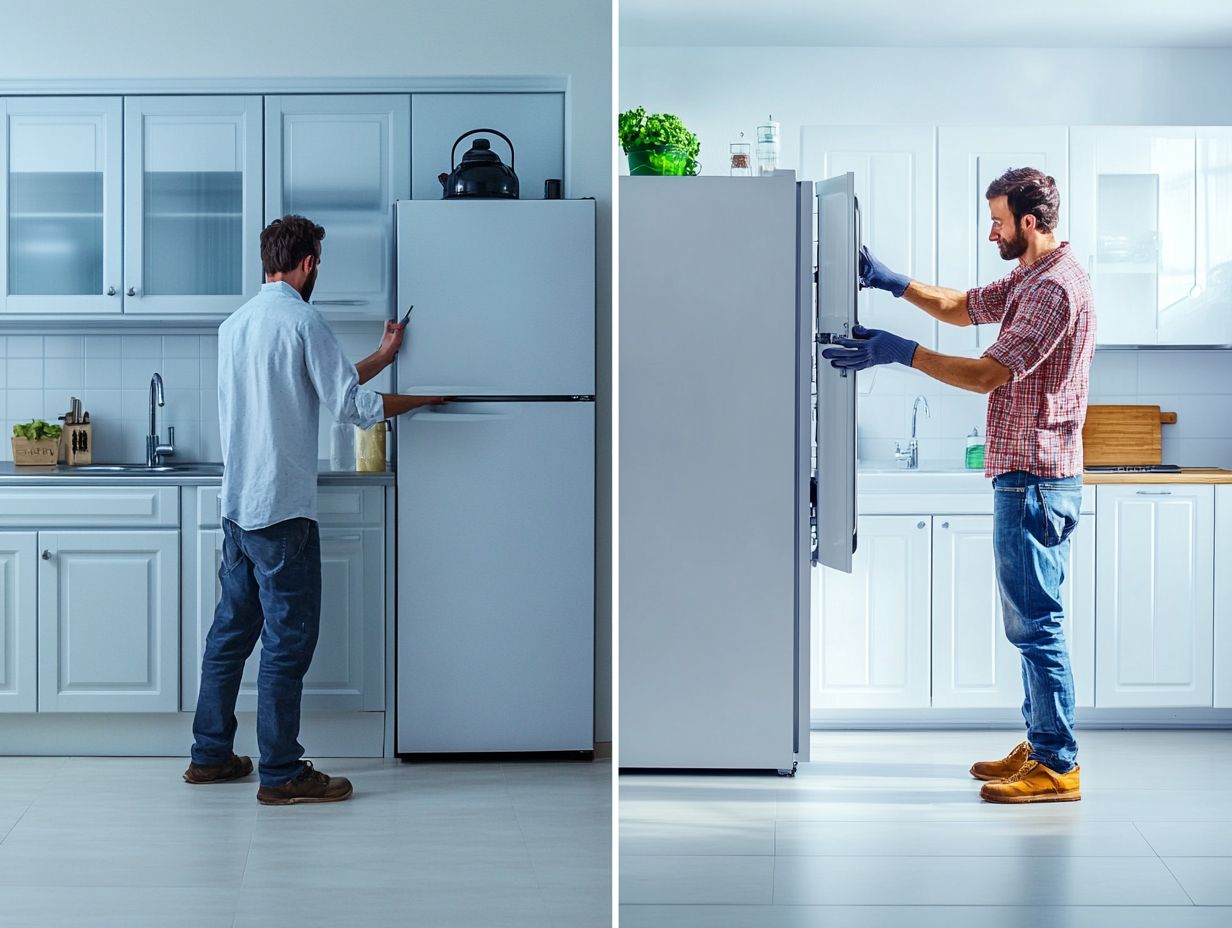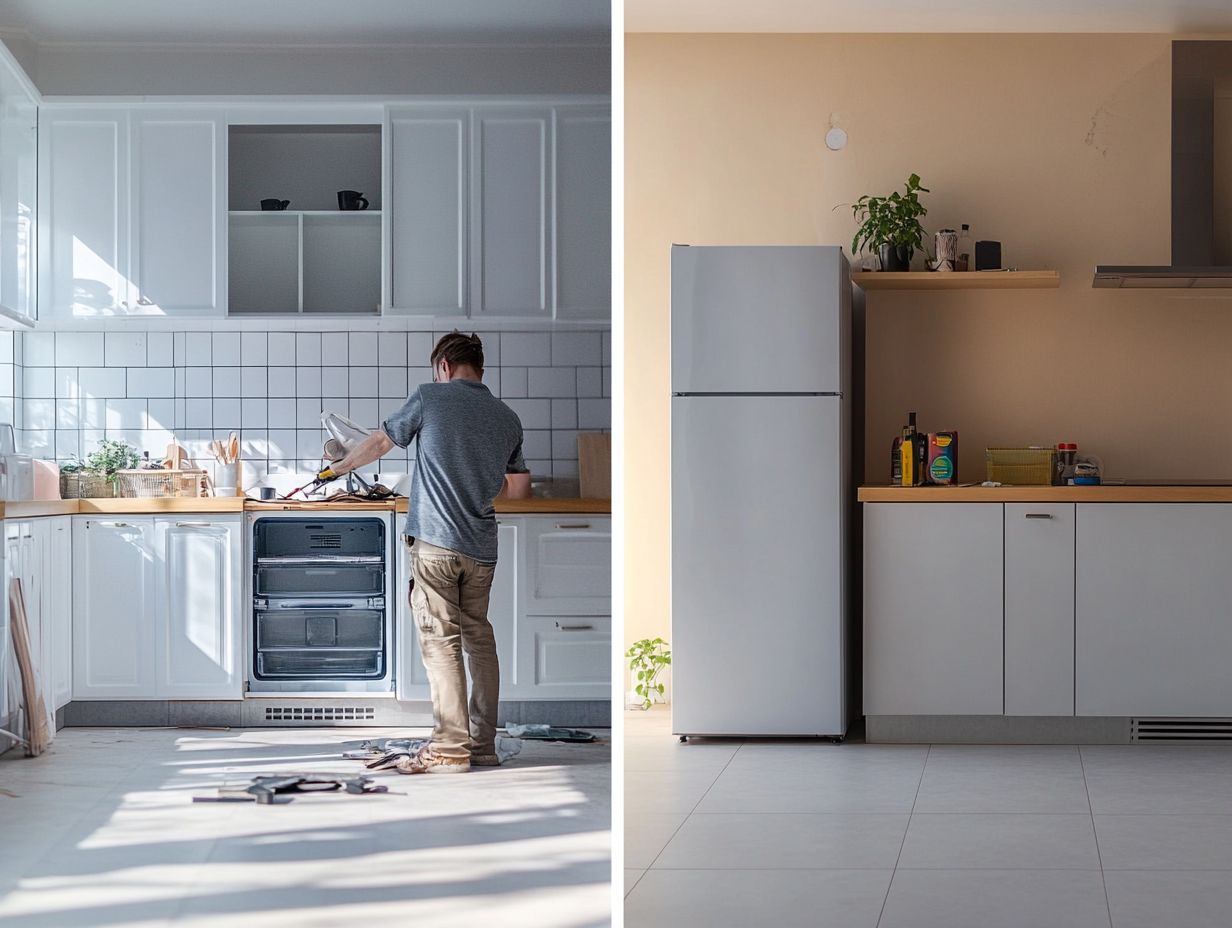Home appliances and systems play a crucial role in our daily lives, and understanding their lifespan can help you save time, money, and reduce stress. Regular maintenance and timely repairs can significantly enhance their longevity, ensuring optimal performance and cost efficiency.
This guide examines the key factors that influence the longevity of these items, identifies signs that indicate when they may need attention, and provides insights on how to make informed decisions regarding repairs or replacements. It also offers detailed cost analysis to help you weigh repair costs against replacement costs effectively.
It also highlights the differences in approach for each type of appliance or system, weighs the pros and cons of DIY repair versus professional assistance, and offers tips to extend their lifespan. Additionally, it discusses the role of energy efficiency and warranty coverage in your decision-making process.
Dive in to make smarter choices for your home!
Understanding the Lifespan of Home Appliances and Systems

Understanding the life expectancy of home appliances and systems is crucial for homeowners who want to maximize their investments in their residences and household items. These appliances and systems are essential for maintaining a functional and safe home. They encompass a wide range of items, including refrigerators, ovens, cooktops, dishwashers, faucets for kitchens and bathrooms, washing machines, dryers, HVAC systems, plumbing, electrical systems, flooring, roofing, and more. A comprehensive consumer guide can assist in making informed decisions about these essential components.
The life expectancy of each component is influenced by average usage patterns, maintenance practices, and advancements in technology. Knowing when to repair or replace these appliances and systems can significantly impact your monthly budget and the long-term value of your home. A chart published by the American Home Shield serves as a handy reference for the life expectancy of various home appliances and systems, along with their average repair and replacement costs. While these figures represent averages, the actual life expectancy may differ depending on specific circumstances. Understanding these factors can help in effective financial planning and budgeting for home improvements.
When deciding whether to repair or replace appliances and systems, homeowners should consider several factors to maximize their longevity. These include warranty coverage, energy consumption, and the availability of replacement parts:
- Energy Consumption: The cost of energy in your area and the energy usage of each appliance (measured in kilowatts per hour) can influence your decision on replacement. As newer appliances tend to be more energy-efficient, replacing older models sooner can help avoid excessive energy costs over time. Energy efficiency ratings and seasonal energy audits can provide valuable insights into the performance of your appliances.
- Repair Costs: The average repair cost for a given appliance or system can guide your decision-making process. If an appliance is still under warranty, the manufacturer typically covers repairs, but often only up to a certain limit. Once the warranty expires, homeowners should weigh average repair costs against the potential lifespan of the appliance. Understanding repair frequency and the economic factors involved can aid in making an informed decision.
- Age: While the age of an appliance or system is an important factor to consider, it should not be the sole criterion for assessing life expectancy. Many systems and appliances can exceed their expected lifespan. Thus, age should be evaluated alongside other considerations such as maintenance and repair history. Keeping a detailed repair history can offer insights into the remaining service life of the appliance.
- Warranty: Most appliances and systems come with some form of warranty, which can aid in deciding when to replace them. For example, if a warranty covers parts and labor for the first five years, it suggests that the manufacturer believes the appliance will last at least that long. Homeowners should also ensure they have coverage for any unexpected breakdowns that may occur shortly after the warranty period. Understanding warranty coverage and its limitations is crucial for protecting your investments.
- Maintenance: Regular maintenance plays a key role in extending the life expectancy of appliances and systems. Neglecting maintenance can lead to the need for replacement parts, which may have their own life expectancies that differ from those of the appliances themselves. Homeowners should commit to diligent maintenance to ensure they derive the full lifespan from their appliances and systems. Adhering to an appliance maintenance schedule and performing seasonal checks can prevent unexpected breakdowns.
Factors that Affect Longevity and Performance
The longevity of home appliances and systems is influenced by several key factors, which can significantly affect their performance, efficiency, and overall costs. Regular maintenance, the age of the appliance, and manufacturer recommendations all impact how long an appliance can function effectively. Additionally, energy efficiency, system performance, and repair history can determine whether it is more advantageous to repair or replace an appliance, thus affecting its overall efficiency and performance. Thorough troubleshooting and understanding appliance efficiency ratings can further guide these decisions.
Understanding the factors that influence the longevity of home appliances and systems enables consumers to make informed decisions that maximize the lifespan of their valuable investments. For instance, regular maintenance can prevent minor issues from escalating into major problems and may even enhance the efficiency of many appliances, leading to lower energy bills. Staying informed about technological advancements and energy efficiency improvements can help consumers replace aging appliances with newer models that are less prone to breakdowns and consume less energy. This knowledge is vital for making effective home improvement decisions.
Awareness of performance issues allows consumers to identify when to address concerns, while maintaining a detailed repair history provides insight into the reliability of a product. Furthermore, understanding proper usage and being aware of repair costs can aid consumers in evaluating the financial implications of necessary future repairs or replacements. This proactive approach helps in maintaining home safety and adhering to current safety standards.
- Regular Maintenance: Essential for extending the lifespan of appliances, regular maintenance helps to avoid larger issues down the line and can improve efficiency in many cases.
- Age: Appliances and systems naturally deteriorate over time, becoming less efficient. It is crucial to monitor the age of appliances and to replace them when they have outlived their usefulness. New replacement products typically feature the latest energy-efficient technology, which can reduce overall energy costs. This is essential for maintaining home value and achieving long-term savings.
- Manufacturer Recommendations: Each appliance comes with specific guidelines regarding servicing frequency and methods. Adhering closely to these guidelines is important for optimal performance. Following expert recommendations can further enhance the lifespan of your appliances.
- Energy Efficiency: Newer, energy-efficient appliances tend to have longer lifespans since they do not have to work as hard. Utilizing energy-efficient appliances helps minimize the risk of breakdowns. Energy Star ratings can be an excellent indicator of an appliance’s efficiency and potential longevity.
- System Performance: Appliances that operate at or above their expected performance levels are less likely to fail. Understanding the expected performance metrics and monitoring for any deviations is crucial for extending an appliance’s longevity. A home energy audit can help identify performance issues and recommend solutions.
- Repair History: Being aware of an appliance’s repair history can provide insights into the likelihood of future issues. Keeping a log of repairs and the circumstances that prompted them is an effective way to stay on top of maintenance and assess the remaining lifespan of the appliance. This knowledge can inform decisions about buying or selling a home or replacing appliances. Regular updates on market trends and appliance recalls can also influence your decisions.
- Proper Use: Appliances are designed for specific functions, and incorrect usage can significantly reduce their lifespan, particularly for heating and cooling systems. Familiarity with the correct operation of appliances can help consumers gauge how long they will last. Instruction manuals and user reviews often provide valuable insights into proper usage and common issues.
- Repair and Replacement Costs: Understanding the costs associated with repairing or replacing an appliance is essential for effective budgeting. Many manufacturers offer warranties that help mitigate repair and replacement expenses; however, comprehending the full scope of maintenance costs is vital for financial planning. Familiarity with repair tools, replacement parts, and service technicians can aid in managing these costs effectively.
Signs that Your Appliance/ System Needs Attention
The safety and efficiency of a home environment rely on the ability to recognize and diagnose when appliances and systems need attention. This may involve detecting visual signs of degradation, experiencing unexpected mechanical failures, or observing performance deterioration that leads to inefficiency. Regular check-ups and home energy audits can help in early identification of these issues.
Proactive intervention is essential for homeowners to avoid costly repairs. Routine inspections and troubleshooting are necessary for identifying potentially harmful issues early on. This ensures that appliances such as refrigerators, ovens, and HVAC systems operate at optimal performance levels, which not only improves energy efficiency but also extends their overall lifespan. Being aware of replacement indicators and repair indicators can help in making timely decisions.
Common Warning Signs

Common warning signs that indicate your appliances and systems may need repair include unusual noises, leaks, and inconsistent performance. For instance, kitchen appliances such as dishwashers and ovens may display inefficiency through longer cooking times or improper heating. Similarly, HVAC systems might produce strange sounds or fail to provide adequate cooling or heating.
Early recognition of these warning signs can help homeowners seek appropriate repair services, ultimately ensuring the safety and functionality of their appliances. Emergency repairs might be necessary in some cases to prevent further damage and maintain home safety.
In the laundry room, excessive vibration during spin cycles or failure to drain properly can signal that washing machines are struggling and require attention. Likewise, a dryer that takes multiple cycles to effectively dry clothes might be suffering from lint buildup or mechanical issues. Regular maintenance and proper use of these appliances can prevent frequent breakdowns.
Additionally, in plumbing systems, persistent leaks or a sudden increase in water bills without any explanation can indicate the need for urgent repairs. Promptly noticing these warning signs not only helps avoid costly repairs but also extends the lifespan of valuable appliances and systems, contributing to a well-maintained home environment. Utilizing eco-friendly options for repairs and replacements can also be beneficial for reducing environmental impact and improving home efficiency.
Repairing vs. Replacing: Making the Decision – A Cost-Benefit Analysis
Several factors influence the decision to repair or replace an appliance, including repair costs, replacement costs, and the appliance’s overall lifespan. Homeowners must weigh the potential benefits of repairing the appliance against the cost-effectiveness of purchasing a new, more efficient model. Additionally, considering replacement indicators and repair indicators can help guide this decision.
Understanding the age of the appliances, their efficiency, and any performance issues can aid in making this decision. Budget considerations are also crucial, as they play a significant role in determining whether to opt for repair services or complete replacements, ultimately impacting long-term investments in the home. Evaluating appliance breakdown frequency and repair frequency can provide further insights.
Cost Analysis and Other Considerations
A cost analysis is essential for determining whether to repair or replace home appliances and systems. Both current repair costs and future replacement costs should be taken into account, along with potential savings from improved energy efficiency and the associated environmental costs and benefits. Assessing the reliability of appliances and considering potential warranty coverage can provide valuable insight into their overall value, leading to more cost-effective and sustainable decisions.
|||
A cost analysis is essential for determining whether to repair or replace home appliances and systems. Both current repair costs and future replacement costs should be taken into account, along with potential savings from improved energy efficiency and the associated environmental costs and benefits. Assessing the reliability of appliances and considering potential warranty coverage, along with warranty coverage specifics, can provide valuable insight into their overall value, leading to more cost-effective and sustainable decisions.
A cost analysis is essential for determining whether to repair or replace home appliances and systems. Both current repair costs and future replacement costs should be taken into account, along with potential savings from improved energy efficiency and the associated environmental costs and benefits. Assessing the reliability of appliances and considering potential warranty coverage can provide valuable insight into their overall value, leading to more cost-effective and sustainable decisions.
To perform a comprehensive cost analysis, individuals should first gather information on the operating costs of their appliances as they currently stand, which can include examining utility bills to identify energy consumption trends over time. It is important to evaluate how much energy each option uses and compare that with the savings offered by newer, more energy-efficient models. Additionally, calculating the environmental costs in terms of carbon emissions and other metrics can provide further context for the decision. Considering eco-friendly options and disposal considerations for old appliances is also beneficial.
Finally, reviewing insurance quotes, repair service costs, expected lifespan, and efficiency ratings of replacement options will enable individuals to make a more informed decision. This should include factors such as parts availability and service technicians accessibility.
Appliances vs. Systems: Different Approaches

Understanding the distinction between appliances and systems in home improvement is essential, as their maintenance and repair strategies differ significantly.
Appliances, such as refrigerators and ovens, typically require repair services focused on their specific functionality. In contrast, home systems like plumbing, HVAC, and electrical systems necessitate a broader range of upkeep and efficiency measures.
|||
Understanding the distinction between appliances and home systems in home improvement is essential, as their maintenance and repair strategies differ significantly.
Appliances, such as refrigerators and ovens, typically require repair services focused on their specific functionality. In contrast, home systems like plumbing, HVAC, and electrical systems necessitate a broader range of upkeep and efficiency measures.
Understanding the distinction between appliances and systems in home improvement is essential, as their maintenance and repair strategies differ significantly.
Appliances, such as refrigerators and ovens, typically require repair services focused on their specific functionality. In contrast, home systems like plumbing, HVAC, and electrical systems necessitate a broader range of upkeep and efficiency measures.
By recognizing the unique needs of both appliances and the homes they serve, homeowners can create tailored maintenance schedules that enhance the longevity of appliances and optimize the performance of home systems. This approach includes regular troubleshooting to identify potential issues early on.
Factors to Consider for Each Type
When assessing the maintenance and repair needs of home appliances or systems, several factors should be taken into account. Features such as energy efficiency ratings, compatibility with existing installations, and user reviews can guide purchasing decisions and maintenance practices for appliances. In contrast, for home systems, performance, repair history, and potential for upgrades are crucial for ensuring long-term reliability and functionality.
|||
When assessing the maintenance and repair needs of home appliances or systems, several factors should be taken into account. Features such as energy efficiency ratings, compatibility with existing installations, and user reviews can guide purchasing decisions and maintenance practices for appliances. In contrast, for home systems, performance, repair history, and potential for upgrades are crucial for ensuring long-term reliability and functionality. Consumer advice and guide materials can also be very useful.
When assessing the maintenance and repair needs of home appliances or systems, several factors should be taken into account. Features such as energy efficiency ratings, compatibility with existing installations, and user reviews can guide purchasing decisions and maintenance practices for appliances. In contrast, for home systems, performance, repair history, and potential for upgrades are crucial for ensuring long-term reliability and functionality.
Additionally, it is important to evaluate the expected lifespan of the appliances or systems in question. The cost of potential repairs should be weighed against the cost of replacement, particularly in situations where reliability may be an issue. Considerations of service life and appliance performance play significant roles in this evaluation.
Establishing regular maintenance schedules can enhance the longevity of both appliances and systems, highlighting the importance of knowing when to schedule inspections or tune-ups. Furthermore, advancements in technology, such as smart home features and automation, can improve usability and reduce maintenance needs over time, making informed consumer choices even more essential. Regular home energy audits can help identify areas for improvement.
DIY vs. Professional Repair/Replacement
Deciding whether to undertake a DIY home appliance repair or replacement or to call in a professional service depends on several factors, including cost-effectiveness, the complexity of the repair, and the reliability of the appliance.
|
Deciding whether to undertake a DIY home appliance repair or replacement or to call in a professional service depends on several factors, including cost-effectiveness, the complexity of the repair, and the reliability of the appliance. The availability of repair tools and replacement parts should also be considered.
|
Deciding whether to undertake a DIY home appliance repair or replacement or to call in a professional service depends on several factors, including cost-effectiveness, the complexity of the repair, and the reliability of the appliance.
DIY repair is a viable option for minor home appliance issues, enabling homeowners to save on repair costs while gaining hands-on experience. However, for emergency repairs or complex systems, hiring a professional repair service is advisable, as it ensures safety, proper functionality, and long-term reliability.
Pros and Cons of Each Option

Homeowners must carefully consider the advantages and disadvantages of DIY repairs versus professional services when faced with appliance issues. One of the key benefits of DIY repair is the potential for cost savings, along with the satisfaction of completing a project independently, especially for simpler repairs that do not require specialized tools or knowledge. In contrast, professional repair services may come at a higher cost, but they offer the expertise and training necessary to ensure that repairs are performed correctly and safely, thereby enhancing the efficiency and longevity of appliances.
|||
Homeowners must carefully consider the advantages and disadvantages of DIY repairs versus professional services when faced with appliance issues. One of the key benefits of DIY repair is the potential for cost savings, along with the satisfaction of completing a project independently, especially for simpler repairs that do not require specialized tools or knowledge. In contrast, professional repair services may come at a higher cost, but they offer the expertise and training necessary to ensure that repairs are performed correctly and safely, thereby enhancing the efficiency and longevity of appliances. Consumer protection and appliance recalls are also important considerations.
Homeowners must carefully consider the advantages and disadvantages of DIY repairs versus professional services when faced with appliance issues. One of the key benefits of DIY repair is the potential for cost savings, along with the satisfaction of completing a project independently, especially for simpler repairs that do not require specialized tools or knowledge. In contrast, professional repair services may come at a higher cost, but they offer the expertise and training necessary to ensure that repairs are performed correctly and safely, thereby enhancing the efficiency and longevity of appliances.
When deciding between these two options, homeowners should weigh various factors. Simpler tasks, such as changing a refrigerator water filter or cleaning a washing machine drain pump filter, are well-suited for DIY efforts, as they typically require only limited tools and minimal technical skill.
However, more complex repairs involving appliances like dishwashers or HVAC systems often necessitate the expertise of professional technicians. Their precision and extensive training contribute to higher success rates in repairs. Referring to repair manuals and consumer guides can also be helpful.
While tools and equipment can significantly influence the success of DIY repairs, professionals are equipped with the appropriate tools to handle more complicated tasks. Ultimately, the decision should be based on the homeowner’s comfort level with the appliance and the severity of the issue at hand.
Maintaining and Extending the Lifespan of Your Appliances and Systems
Adopting a comprehensive maintenance schedule is essential for extending the lifespan of home appliances and systems, ensuring their functionality and safety for homeowners.
Regular inspections and seasonal maintenance can reduce the risk of breakdowns, enhance efficiency, and ensure the proper operation of a variety of appliances, including HVAC systems, kitchen appliances, and laundry equipment.
|||
Adopting a comprehensive maintenance schedule is essential for extending the lifespan of home appliances and systems, ensuring their functionality and safety for homeowners. Regular updates to appliance efficiency ratings can also guide these efforts.
Regular inspections and seasonal maintenance can reduce the risk of breakdowns, enhance efficiency, and ensure the proper operation of a variety of appliances, including HVAC systems, kitchen appliances, and laundry equipment. Ensuring compliance with safety standards is also crucial.
Adopting a comprehensive maintenance schedule is essential for extending the lifespan of home appliances and systems, ensuring their functionality and safety for homeowners.
Regular inspections and seasonal maintenance can reduce the risk of breakdowns, enhance efficiency, and ensure the proper operation of a variety of appliances, including HVAC systems, kitchen appliances, and laundry equipment.
Proactive maintenance not only helps homeowners protect their investments but also promotes long-term reliability of their appliances. Regular troubleshooting and updating repair history logs can help identify and address potential issues early.
Tips and Tricks for Longevity
Proper maintenance of home appliances and systems is essential for maximizing their longevity. Simple actions such as cleaning filters, checking seals, and conducting annual inspections can enhance energy efficiency and safety.
|||
Proper maintenance of home appliances and systems is essential for maximizing their longevity. Simple actions such as cleaning filters, checking seals, and conducting annual inspections can enhance energy efficiency and safety. Following consumer advice and using repair tools effectively can also contribute to better upkeep.
Proper maintenance of home appliances and systems is essential for maximizing their longevity. Simple actions such as cleaning filters, checking seals, and conducting annual inspections can enhance energy efficiency and safety.
By being proactive and attentive to the needs of household items, we can extend their lifespan and minimize repair costs. Seasonal maintenance can also be very beneficial; for instance, checking smoke detectors at the beginning of each season can help identify issues early on. Regular home energy audits can further optimize energy use.
Homeowners should monitor condensation levels in basements and attics, as excess moisture can lead to mold problems that negatively impact air quality and appliance performance. Additionally, improving energy efficiency by upgrading to energy-star-rated appliances can save money on utility bills while also reducing environmental impact. Staying up-to-date with appliance innovation and market trends can also guide better purchasing decisions.


